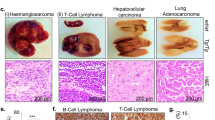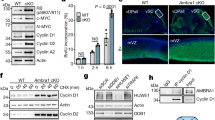Abstract
The Cul4A gene, which encodes a core component of a cullin-based E3 ubiquitin ligase complex, is overexpressed in breast and hepatocellular cancers. In breast cancers, overexpression of Cul4A strongly correlates with poor prognosis. In addition, Cul4A is required for early embryonic development. The early lethality of mouse embryos prevented a detailed analysis of the functions of Cul4A. Here, we used a strain of mice carrying floxed alleles of Cul4A to study its role in cell division, in vitro and in vivo. Embryonic fibroblasts (MEFs) show a severe deficiency in cell proliferation after deletion of Cul4A. We observed that the Cul4A protein is abundantly expressed in the brain, liver and the mammary tissue of pregnant mice. Deletion of Cul4A in the liver impairs hepatocyte proliferation during regeneration after carbon tetrachloride (CCl4)-induced injury. The Cul4A-deleted cells are slow in entering the S phase, and are deficient in progressing through the early M phase. Several cell-cycle regulators, including p53 and p27Kip1, are deregulated in the Cul4A-deleted cells. Expression of a dominant negative mutant of p53 causes significant reversal of the proliferation defects in Cul4A-deleted cells. The Cul4A-deleted cells show an aberrant number of centrosome, multipolar spindles and micronuclei formation. Furthermore, those cells are sensitive to UV irradiation and show reduced levels of unscheduled DNA synthesis (UDS). Together, our observations indicate that Cul4A is required for efficient cell proliferation, control of centrosome amplification and genome stability.
This is a preview of subscription content, access via your institution
Access options
Subscribe to this journal
Receive 50 print issues and online access
$259.00 per year
only $5.18 per issue
Buy this article
- Purchase on Springer Link
- Instant access to full article PDF
Prices may be subject to local taxes which are calculated during checkout






Similar content being viewed by others
References
Abba MC, Fabris VT, Hu Y et al. (2007). Identification of novel amplification gene targets in mouse and human breast cancer at a syntenic cluster mapping to mouse ch8A1 and human ch13q34. Cancer Res 67: 4104–4112.
Banks D, Wu M, Higa LA, Quan J, Ye T, Kobayashi R et al. (2006). L2DTL/CDT2 and PCNA interact with p53 and regulate p53 polyubiquitination and protein stability through MDM2 and CUL4A/DDB1 complex. Cell Cycle 5: 1719–1729.
Belzile JP, Duisit G, Rougeau N, Mercier J, Finzi A, Cohen EA. . (2007). HIV-1 Vpr-Mediated G2 Arrest Involves the DDB1-CUL4A(VPRBP) E3 Ubiquitin Ligase. PLoS Pathog 3: e85.
Bergametti F, Sitterlin D, Transy C . (2002). Turnover of hepatitis B virus X protein is regulated by damaged DNA-binding complex. J Virol 76: 6495–6501.
Bondar T, Kalinina A, Khair L, Kopanja D, Bagchi S, Raychaudhuri P . (2006). Cul4A and DDB1 associate with Skp2 to target p27Kip1 for proteolysis involving COP9 signalosome. Mol Cell Biol 26: 2531–2539.
Bondar T, Ponomarev A, Raychaudhuri P . (2004). Ddb1 is required for the proteolysis of the Schizosaccharomyces pombe replication inhibitor Spd1 during S phase and after DNA damage. J Biol Chem 279: 9937–9944.
Cang Y, Zhang J, Nicholas SA, Bastien J, Li B, Zhou P et al. (2006). Deletion of DDB1 in mouse brain and lens leads to p53-dependent elimination of proliferating cells. Cell 127: 929–940.
Chen LC, Manjeshwar S, Lu Y, Moore D, Ljung BM et al. (1998). The human homologue for the Caenorhabditis elegans Cul-4 gene is amplified and overexpressed in primary breast cancers. Cancer Res 58: 3677–3683.
El-Mahdy MA, Zhu Q, Wang QE, Wani G, Praetorius-Ibba M, Wani AA . (2006). Cullin 4A-mediated proteolysis of DDB2 protein at DNA damage sites regulates in vivo lesion recognition by XPC. J Biol Chem 281: 13404–13411.
Fausto N . 1996. Hepatic regeneration. In: Zakim D and Boyer TD (eds) Hepatology A Text Book of Liver Diseases. W.B Saunders Co Philadelphia, pp 32–58.
Fukasawa K . (2005). Centrosome amplification, chromosome instability and cancer development. Cancer Lett 230: 6–19.
Higa LA, Mihaylov IS, sBanks DP, Zheng J, Zhang H . (2003). Radiation-mediated proteolysis of CDT1 by CUL4-ROC1 and CSN complexes constitutes a new checkpoint. Nat Cell Biol 5: 1008–1015.
Higa LA, Yang X, Zheng J et al. (2006). Involvement of CUL4 ubiquitin E3 ligases in regulating CDK inhibitors Dacapo/p27Kip1 and cyclin E degradation. Cell Cycle 5: 71–77.
Holmberg C, Fleck O, Hansen HA., Liu C, Slaaby R, Carr AM et al. (2005). Ddb1 controls genome stability and meiosis in fission yeast. Genes Dev 19: 853–862.
Kim Y, Kipreos ET . (2007). Cdt1 degradation to prevent DNA re-replication: conserved and non-conserved pathways. Cell Div 2: 18.
Li B, Ruiz JC, Chun KT . (2002). Cul4A is critical for early embryonic development. Mol Cell Biol 22: 4997–5005.
Li B, Ruiz JC, Chun KT . (2006). Cul4A targets p27 for degradation and regulates proliferation, cell cycle exit, and differentiation during erythropoiesis. Blood 107: 4291–4299.
Nag A, Bondar T, Shiv S, Raychaudhuri P . (2001). The XP-E gene product DDB2 is a specific target of cullin 4A in mammalian cell. Mol Cell Biol 21: 6738–6747.
Nag A, Bagchi S, Raychaudhuri P . (2004). Cul4A physically associates with MDM2 and participates in the proteolysis of p53. Cancer Res 64: 8152–8165.
Postic C, Magnuson MA . (2000). DNA excision in liver by an albumin-Cre transgene occurs progressively with age. Genesis 26: 149–150.
Schindl M, Gnant M, Schoppmann SF, Horvat R, Birner P . (2007). Overexpression of the human homologue for Caenorhabditis elegans cul-4 gene is associated with poor outcome in node-negative breast cancer. Anticancer Res 2: 949–952.
Serfas MS, Goufman E, Feuerman MH, Gartel AL, Tyner AL . (1997). P53-independent induction of p21Waf1/Cip1 expression in pericentral hepatocytes following carbon tetrachloride intoxication. Cell Growth & Diff 8: 951–961.
Shinmura K, Bennett RA, Tarapore P, Fukasawa K. . (2007). Direct evidence for the role of centrosomally localized p53 in the regulation of centrosome duplication. Oncogene 26: 2939–2944.
Smith ML, Ford JM, Hollander MC . (2000). P53-mediated DNA repair responses to UV radiation: studies of mouse cells lacking p53, p21 and/or gadd45 genes. Mol Cell Biol 20: 3705–3714.
Ulane CM, Horvath CM . (2002). Paramyxoviruses SV5 and HPIV2 Assemble STAT Protein Ubiquitin Ligase Complexes from Cellular Components. Virology 304: 160–166.
Waning DL, Li B, Jia N, Naaldijk Y, Goebel WS, HogenEsch H et al. (2008). Cul4A is required for hematopoietic cell viability and its deficiency leads to apoptosis. Blood 112: 302–309.
Wertz I E, O′Rourke KM, Zhang Z, Dornan D, Arnott D, Deshaies RJ et al. (2004). Human De-etiolated-1 regulates c-Jun by assembling a CUL4A ubiquitin ligase. Science 303: 1371–1374.
Yasui K, Arii S, Zhao C, Imoto I, Ueda M, Nagai H et al. (2002). TFDP1, CUL4A, and CDC16 identified as targets for amplification at 13q34 in hepatocellular carcinomas. Hepatology 35: 1476–1484.
Zhang Y, Morrone G, Zhang J, Chen X, Lu X, Ma L et al. (2003). Cul-4A stimulates ubiquitylation and degradation of the HOXA9 homeodomain protein. EMBO J 22: 6057–6067.
Acknowledgements
The Cul4A fl/fl mouse strain was generated in collaboration with Xenogen Biosciences, NJ, USA. The work was supported by grants from the National Institute of Health (CA 77637 to PR and AG 02413 to PR and SB).
Author information
Authors and Affiliations
Corresponding authors
Additional information
Conflict of interest
The authors declare no conflict of interest.
Supplementary Information accompanies the paper on the Oncogene website (http://www.nature.com/onc)
Rights and permissions
About this article
Cite this article
Kopanja, D., Stoyanova, T., Okur, M. et al. Proliferation defects and genome instability in cells lacking Cul4A. Oncogene 28, 2456–2465 (2009). https://doi.org/10.1038/onc.2009.86
Received:
Revised:
Accepted:
Published:
Issue Date:
DOI: https://doi.org/10.1038/onc.2009.86
Keywords
This article is cited by
-
Characterization of the microRNA transcriptomes and proteomics of cochlear tissue-derived small extracellular vesicles from mice of different ages after birth
Cellular and Molecular Life Sciences (2022)
-
Genetically engineered mouse models for functional studies of SKP1-CUL1-F-box-protein (SCF) E3 ubiquitin ligases
Cell Research (2013)
-
The Cul4A–DDB1 E3 ubiquitin ligase complex represses p73 transcriptional activity
Oncogene (2013)
-
COP9 signalosome subunit 8 is required for postnatal hepatocyte survival and effective proliferation
Cell Death & Differentiation (2011)



